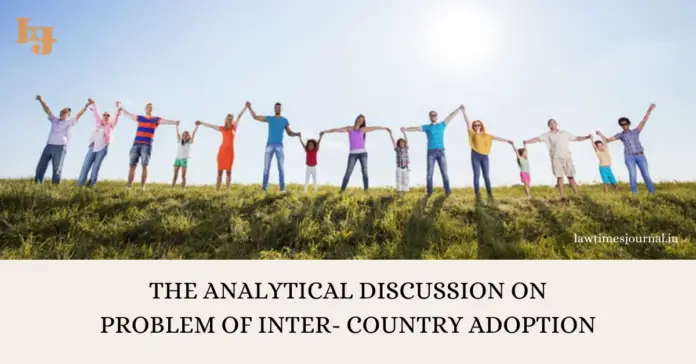
Adoption is a welfare and protection measures that enables an orphaned or abandoned child to benefit from a permanent family. Primarily the adoption was done in domestic phenomena only. A domestic or national adoption involves adoptive parents and a child of the same nationality and the same country of residence. But in inter-country adoption, the adoption is done in two different countries like if the parents are resident of the United States and they want to adopt the child from India.
The concept of inter-country adoption mainly emerged after the cold war. It came as an adhoc humanitarian for those children who lost their parents in war and are orphan. Families in United States, Canada, Europe and Australia adopted children from Italy, Greece, Germany and others. Although, there were no legal mechanisms for adoption at that point of time. In 1960’s a seminar on inter-country adoption was organized in Leysin, Switzerland under the auspices of the European office of the United Nations which formulated the first set of principles in this sphere. After that a world conference was held in Milan, Italy on Adoption and Foster Care in 1971. The conference focused its attention on International regulation to safeguard the interest of child who are adopted. The Hong Kong Conference of 1996 and the Brighten Guidelines of 1982 revised and endorsed these guidelines.
The most remarked efforts in order to ensure the protection of children’s right for the purpose of intercountry adoption was done in Hague Convention of 1993. Similarly, the provisions of the United Nations Convention on the Rights of Child, 1989 also followed when considering domestic and international or inter-country adoption for a child. By seeing the information of October 2002 the guidelines on inter-country laid down in the Hague Convention have been ratified by 38 States including Russia and China and it is predicted that most countries will also come along.
In India the Supreme Court guidelines for inter-country adoption laid down in the Laxmikant Pandey judgment and the Guardian and Wards Act, 1890 are a pointer in this direction. Thus in India inter-country adoption has come to stay. The guidelines laid down by the Supreme Court in this regard have started gaining momentum. The Government of India in pursuance of Apex Court’s directions has established a Central Adoption Resource Authority (CARA) to act as a clearing home of information with regard to children available for inter-country adoption and to regulate, monitor and develop programs for the rehabilitation of children through adoption. This judgment has laid down certain guidelines and principles, norms and procedures for adoption in order to ensure the welfare of the child. The judgment has been delivered by Justice P. N. Bhagwati for himself, R. S. Pathak and Amrinder Nath Sain JJ. Since we do not have a uniform adoption law, the judgment gave directives and guidelines in processing adoptions under the Guardian and Wards Act, 1890.
The inter-country adoption is not as simple or secured as it looks like. Many times there has been a misuse of this protocol children are adopted and they are used for different illegal purpose. The “internet twins case” which is unresolved and it has made it as a household issue- the case helps to illustrate some of the emotional and legal difficulties raised when adopting children from a foreign land. However, the adoption of children from India by foreigners has given rise to malpractices. Indian children are taken abroad for unscrupulous persons, domestic purposes, and prostitution and are mainly exploited for trafficking. Judicial cognizance of these aspects was taken by the Gujarat High Court in 1992 and while dealing with this adoption the court observed that the entire movement is not foolproof. “It is not free from abuse and aberrations. The possible existence of an international racket trading in such children and selling them at profit into slavery or prostitution cannot be altogether ruled out.”
Inter-country adoption is one of the most controversial, sensitive and complex aspect of adoption which involves a number of principles and procedures over migration, citizenship, the socio-economic situation of adoptive parents, matching parents with the child and acceptance of the child in a different community and culture. It requires the participation of the adoption agencies or authorities in the overseas countries. Similar views have been expressed by the New South Wales, Law Reform Commission on Inter-Country Adoption.
“The views of the authors are personal“
Frequently Asked Questions
What is Inter-Country Adoption?
Adoption is a welfare and protection measures that enables an orphaned or abandoned child to benefit from a permanent family. In intercountry adoption, the adoption is done in two different countries as if the parents are residents of the United States and they want to adopt the child from India.
How does the concept of Inter-Country Adoption emerge?
The concept of inter-country adoption mainly emerged after the cold war. It came as an Adhoc humanitarian for those children who lost their parents in war and are orphans. Families in the United States, Canada, Europe, and Australia adopted children from Italy, Greece, Germany, and others.
When did the legal mechanism of Inter-Country Adoption come?
In the 1960s a seminar on inter-country adoption was organized in Leysin, Switzerland under the auspices of the European office of the United Nations which formulated the first set of principles in this sphere. After that a world conference was held in Milan, Italy on Adoption and Foster Care in 1971. The conference focused its attention on International regulation to safeguard the interest of the child who are adopted. The Hong Kong Conference of 1996 and the Brighten Guidelines of 1982 revised and endorsed these guidelines.








